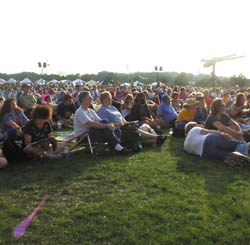In addition to covering the Boston Folk Festival for the Mass Media, I was also one of three hundred volunteers supporting the Festival this year. Naturally it’s a great way to check out great music for free. It’s also a fantastic way to meet people of all interests and ages, and the T-shirt I got is pretty buff, too.
For anyone thinking that the UMB Folk Festival must be staffed by a bunch of retired flower children, guess again. The Folk Festival actually draws an all-ages crowd that knows how to let loose, and features music from a dozen genres from bluegrass to zydeco, all of which kick pop radio’s tushie. Sponsored by WUMB Folk Radio, the festival celebrated its 5th anniversary this year, while the radio station celebrated its 20th. Attendance at the Festival on Saturday was estimated at over 3,000; this figure jumped up to about 5,500 for Sunday.
For such a massive operation, the Festival was run very professionally — and smoothly, too. Each of the five performance areas had its own stage manager, who was in charge of organizing volunteers, distributing the workload, delegating responsibilities and keeping the flow of communication going.
The Festival was divided up into four stages, as well as the Chanteyboat, making five venues in which to see performers. Most people’s memories of the festival start and end with the Field Stage — on any other day, UMass Boston’s soccer field. In addition to selling tickets, the Field Stage also had tables for volunteers and the press. The field was ringed with booths for about thirty different vendors, offering everything from songbooks and musical instruments to refreshments.
Most importantly, the Field Stage had the largest stage and the most popular performers. From The Waifs to C.J. Chenier, from Iris DeMent to Nanci Griffith, the Field Stage attracted an enormous crowd — by some estimates, over two thousand people on blankets and lawn chairs.
The Plaza Stage was also a popular venue, with performers like Southern Rail and Utah Phillips pleasing the crowd. There were chairs set up for three hundred, and standing room available for many, many more. However, the Plaza Stage was about as far into the “interior” of UMass Boston as the public was able to penetrate, and it might be nice in future years to showcase the McCormack Theatre and Snowden Auditorium, as has been done in the past.
For those who like smaller venues, the Upper Level of the Quinn Administration Building by the Java Coast vendor was turned into a coffeehouse. Unfortunately, the elevators and cafeteria generated a lot of traffic, which occasionally provided competition for the performer onstage. Still, it was delightful to see duets such as Small Potatoes, or artists such as Jack Williams, a fingerstyle guitarist, whose intimate performance might have been lost on a larger stage.
I was assigned as a volunteer to the Fox Point Pavilion, down by the waterside. The Pavilion included not just a stage and dance floor, but also a children’s crafts area and the dock for the Chanteyboat.
Since Chris Sweeney, my stage manager, also heads up Marine Operations at UMB, dockside activities ran really smoothly. Unfortunately, the tour sold out really quickly both days — within ten minutes of when we started taking reservations. This meant a lot of discouraged visitors throughout the day, but with such good music all around, no one was upset for too long.
The children’s area was a complete blast. I had fun working with Aniko, Megan, and Heather, helping kids make kites and tambourines. In between groups of children we’d chill out and talk about other festivals to which we’d gone. I even helped pull a kite out of a tree.
Some volunteers, like Pepper, have been going to festivals for over twenty years, or (like Jim) work for coffeehouses in the area, and so can talk about the culture with seniority. Still others work with the radio station or the university.
I was able to talk with many of the musicians before or after their set. Billy Jonas, who plays what he calls “junkadelic music,” was just as exciting offstage as when he was performing. And the Arseneault family, who perform as Barachois (Barra-SHWAH) were willing to entertain myself and several others with tales of maritime Canada. Many of the performers used the dance floor, but none so well as Barachois, who ended their set with solos for each of them and an ensemble dance.
I was also able to meet the four members of Southern Rail, who played a fantastic set of mostly bluegrass music. Jim and Sharon traded friendly jokes about the length of their marriage. Onstage, they impressed the crowd with pleasers such as “East Tennessee Blues” and “Long Gone,” both of which afforded plenty of opportunities to trade off licks between guitar, mandolin, and banjo.
I was glad to be at the Fox Point Pavilion when C.J. Chenier played his set. His appearance on the Field Stage was unfortunately marred by technical difficulties, cutting his playing time almost in half. Needless to say, his set at the Pavilion was much sharper, and got the crowd on their feet and dancing.
Being stationed at the Fox Point Pavilion Stage meant missing out on a few performers. I had already seen Richard Thompson at last year’s festival, but I had really wanted to see Bill Staines live. That’s all right: there’s always next year’s festival.
And for the chance to meet some wonderful people and hear great music? Who wouldn’t want to volunteer!





















































